When a volcano erupts, it ejects solid or molten rock fragments of any size into the surrounding air. The smallest fragments (less than 2 millimeters in diameter) are called ash. Mid-sized fragments (2 to 64 millimeters in diameter) are called lapilli. Anything ejected from a volcano that is larger than 64 millimeters in diameter is called a block if it was ejected in a solid form and a volcanic bomb if it was ejected in a liquid or semi-solid form.
Since volcanic bombs are still viscous when they are ejected, they often have rounded, aerodynamic shapes. They cool into solid fragments before they reach the ground. Lava bombs can be thrown many kilometres from an erupting vent, and often acquire aerodynamic shapes during their flight. Bombs also can be extremely large as you will realize at the cache. Most of the volcanic bombs ejected by an eruption are of irregular shape. They are generally very vesicular and lumpy. Some bombs however have a somewhat streamlined form and are generally ejected during the final stage of an eruption. Some examples (there are many more) might be:
1. Ribbon or cylindrical bombs
These bombs form from highly to moderately fluid magma, ejected as irregular strings and blobs. The strings break up into small segments which fall to the ground intact and look like ribbons. Hence, the name- ribbon bombs. These bombs are circular or flattened in cross section, are fluted along their length, and have tabular vesicles.
2. Spherical bombs
These bombs also form from high to moderately fluid magma. In the case of spherical bombs, surface tension plays a major role in pulling the ejects into spheres.
3. Cow-dung bombs
These are formed when highly fluid magma falls from moderate height (so the bomb does not solidify before impact) which are still liquid when they strike the ground. They consequently flatten or splash and form irregular roundish disks which resemble cow-dung.
4. Bread-crust bombs
Bread crust bombs are created when the bomb cools, producing a hard crust that insulates the inside keeping it hot and full of dissolved gases. The gases continue to expand and break the crust that has already formed. Occasionally the molten interior squeezes out or if the gas expansion is violent, the bomb explodes.
5. Fusiform bombs
These are the "classic" types of bombs referred to in textbooks. They are typically very streamlined, often with elongate "ears" stretching beyond the central bulge. Often, the bomb and the ears are part of a much larger ribbon bomb in which the delicate ribbons separate as the fluid mass flies through the air or break off on impact.
History of the 'Narices del Teide', whose volcanic bombs you will evaluate
In 1798 was the last eruption of a volcano in the 'Cañadas del Teide'. It was NOT the best known mount 'Pico del Teide' but the 'Pico Viejo', the small brother of the mount Teide, which erupted on June 9th on the southwest side and sent 12 million cubic meters of lava and volcanic bombs down to the Cañadas during three months. The eruption was caused by two main craters, which are called 'Narices (nostrils) del Teide' on the island.
The black lava streams - view from the main crater at 2600 meter
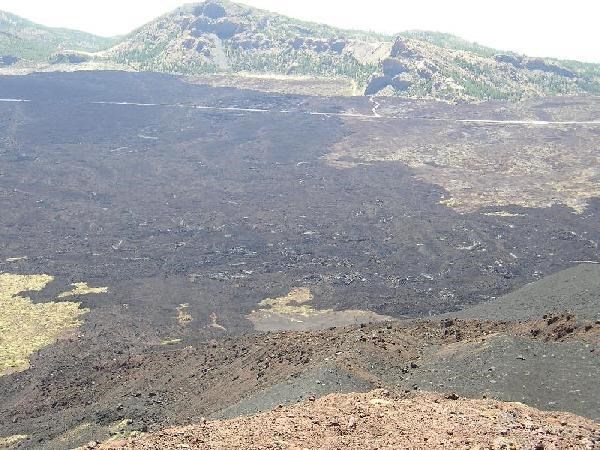
The Hike
To get to your starting point, drive up to the Cañadas and park at 28°13.118 N 016°40.927 W. Have enough water and eventually some food with you. From there you just follow the newly and well signed 'Sendero No.28', which will bring you to the Cache point after a walk of around 5 kilometers and a total height difference of less than 200 meters. This point is still well below the craters of the eruption.
If you want to encounter a whole field of lava bombs, just climb further up the 'Sendero No.28' for another couple hundred meters and you will find the field on your left hand side (terrain diffuculty will however be at least 4).
Being at the cache place and looking at the volcanic bomb there, take a moment to think about the immense force of a volcanic eruption, which is able to throw a rock of this size over a distance like this.
Volcanic bombs from Pico Viejo eruption in 1798
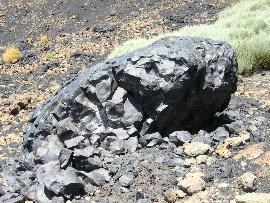
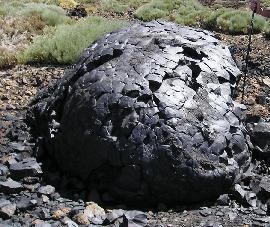
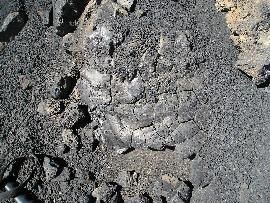
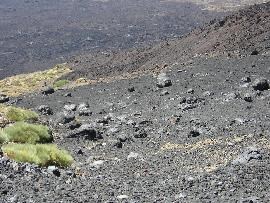
To be allowed to log the cache, your tasks are as follows:
1) Send me the answer to the following questions:
a) What do you think is the weight of the bomb at the coordinates?
b) What type of bomb is it (by using the above definitions)?
c) What is the distance to the craters of 'Narices del Teide'
OPTIONAL: Make a picture of you with your GPS and the bomb in the background and upload it with the log.